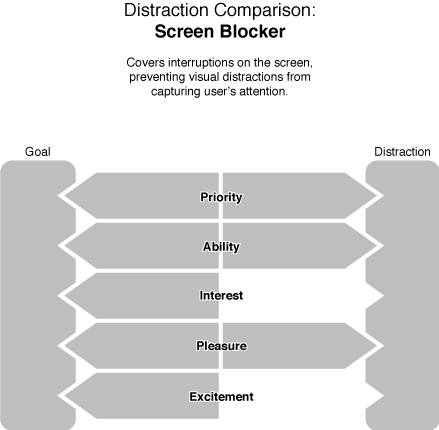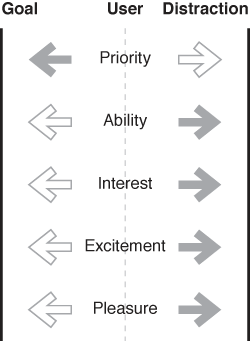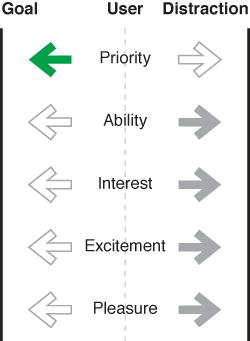Five Forces
To finish up all of the work I did creating models, I simplified it into a framework. I’ve identified five specific forces that influence decisions to concentrate on a goal or switch to a distraction. Ordered by decreasing rationality, those forces are:
Priority. How important is it that I accomplish this goal? For example, deadlines, social pressures, and threats of punishment are good ways to increase a goal’s priority
Ability. Do I know how to accomplish this goal? Training and better interaction design are ways to increase the ability to accomplish a goal.
Interest. Am I interested in accomplishing this goal? Improved visual design might be one way to increase interest in a goal.
Excitement. Does this goal excite me, or is it prompted by something that excites me? Does this goal give me an adrenaline response? A telephone ring or a new IM window popping up would be exciting.
Pleasure. Will I experience pleasure by working on this goal? Does it give me a dopamine response? Rewards would be a good way to increase pleasure.
Sketching
Before making any last models, I took one more pass at sketching:

Then I made a few more diagrams:



Final Model
After one more pass at visually simplifying the framework, I found my final version:

To use this framework, you need start with a specific goal (on the left) and a specific distraction (on the right.) Then you could go through the chart and determine if the force is stronger for the goal, for the distraction, or if it’s not stronger for either. For instance, if you were asked to write a report that you don’t know or care about, you might be distracted by checking out Facebook.

But say your boss came in and told you that you would be fired if you didn’t finish the report by the end of the day. The boss would have significantly increased the goal’s priority, and you would probably not check Facebook. On the diagram, the green arrow indicates that the force has been increased.

Alternatively, you could install a network blocking application such as Freedom. Since you wouldn’t be able to visit Facebook, your ability would have been decreased, as indicated by the red arrow, and you would work on the report instead. Your interest, however, would probably still lie with Facebook.

One other alternative would be to write the report in an application like OmmWriter. Since OmmWriter is full screen, it reduces the excitement of other distractions, since you can’t see them. It also increases the interest in writing the report, because the screen environment looks nicer. It would also increase pleasure because it surprises you with fun sounds as you work.

Having the framework in place allows you to do a few things. First it allows you to compare different goals versus different distractions. Second, it allows you to show the impact of tools on that comparison. Third, it helps to identify the forces that you can design for to improve concentration or reduce distraction.
Copyright © 2010 - 2011 Eric St. Onge
Please send questions or comments to eric at ericstonge dot com.